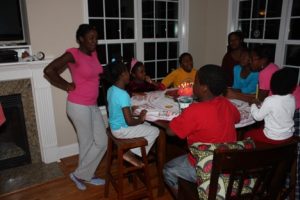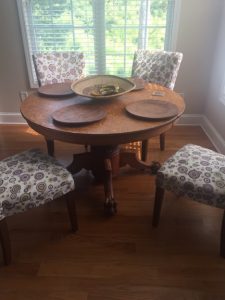My name is Zoe Walker a rising sophomore at Emory and for this particular assignment, I interviewed my Great Aunt Gwen about the history and cultural significance of her 100-year-old dining table. I conducted this particular interview because I feel like it is always important to know the history surrounding your family and your ancestors. Most of the family on my mother’s side now lives here in Georgia so there are always many opportunities to learn more about my history and the family’s migration from all over the world to where we are now. With that in mind, I believe one of the best ways to learn the history and culture of a family is to learn about life and history in the kitchen. As I have learned throughout this course, food is shaped by the people that create the food in each region and more importantly how it is set up and presented for meals. By learning about my great aunt’s dining table and getting to understand it as a cultural artifact, I can delve deeper into the history and culture of my family and how it has been shaped over time.
There are nearly one hundred years of history surrounding my great aunt’s table. Starting off the interview my great aunt mentions that the table was built in 1920 and is an oak round table with a pedestal and legs that are designed to look like lions’ feet. This was very indicative of the design style of that time. It is not as common to find that degree of flair today as tables and chairs have taken on a modern sleeker look. The lions’ feet give the table a regal ancestral feel to it, and to know my great aunt still holds on to it and it’s a focal point in the kitchen was fascinating to me. My great aunt purchased this table from an antique furniture store in her former neighborhood, Corona Heights, New York. She said that she used to shop second-hand stores because her father, my great grandfather, owned a second-hand store used furniture store that had similar furniture to this table, and antique dealers would always come by his store and buy these types of tables from him. By purchasing from a second-hand store she was preserving the history and tradition of her father and the antique dealers who would buy handcrafted tables and other furniture from him. This information surrounding the table was particularly interesting to me because I never knew my great grandfather so to learn this about him and know that our family possessed a table similar to the ones he used to buy and sell was very moving to me.
As mentioned earlier I used the anthropological method of an interview to study the dining table. I chose this method because I wanted to get a personal recounting of the history of the table told from my great aunt who has had it in her possession for so many years. By hearing the history surrounding this table, I was able to be transported to those earlier years of my grandmother, great aunts, and uncles lives that I wasn’t able to personally experience. Throughout the interview, I learned many things surrounding the history of this kitchen table. Along with the history surrounding why my great aunt purchased this table, this table has been the focal points of meals all throughout her adult life. I asked her about her day to day life when she was first living on her own. She told me many stories of living in Queens in a shared 3 story house with my grandmother and their other sister. My grandmother lived on the top floor, my Great Aunt Gwen on the middle floor, and My Great Aunt Sarah on the bottom floor. Even though they each had their own separate areas of living, they always gathered on the second floor to cook and eat together around my Great Aunt Gwen’s table for dinner. The second floor is also where they had family gatherings when their brothers who moved to Washington D.C and California came to visit. I then asked my Aunt Gwen about life surrounding this table once she got married and had kids. I learned that each of my three aunts celebrated many of their birthdays at that table. My great aunt always covered the table with a specific table cloth and baked a cake and all the family in New York would come to celebrate. This tradition continued once my aunts started having kids, and then their kids had kids. Each of my nine cousins has celebrated a birthday at that table which is extremely significant. During the interview, I asked my great aunt if there was anything significant that she keeps on the table. She mentioned that in the center of
the table there is an African basket my mom brought back from Africa when she visited during medical school. This also ties in my African heritage and I thought it was significant that this basket is the centrepiece of this table just like my African history is the center of my family. There are also wooden placemats that have all been written on by her nine grandchildren. She mentioned that while it may like scribbled writings from children, she loves these placemats because they are decorated with the writing of her grandkids.
Overall from this interview, I learned so much about the history surrounding my great aunt and my family. There are so many practices and traditions surrounding this kitchen table that have been ingrained in my aunt and our family. This table has served as a place for all of the family members to gather together no matter what occasion and celebrate together. This table also holds memories created not only from my aunt’s lifetime of having it but for the other families who owned it before it made it to the second-hand store where she bought it. It is obvious that the practices and functions of this table will live on through the next generation of family members who hold on to this 100-year-old table.

Kaya and her birthday cake



Zoe, excellent opening–to the point, clear, responsive to the prompt. You particularly did well on focusing on the kitchen table, throughout the essay. Out of the five prompt questions, you’ve addressed the first (why this study), second (why this table), and third (anthropological methods), very well. In comparison with the other parts, your conclusion (per the prompt, “conclusions about the function, and practices associated with the table”) feels weak. I wish you’d be more articulate and reflexive about all the things you’ve learned from this experience, and perhaps, in connection with what you’ve learned from the class discussions. Thanks for providing all the lovely photos!